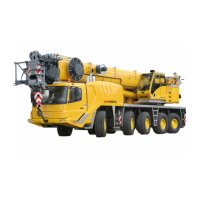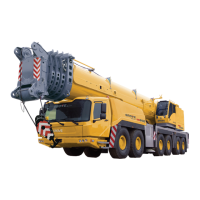Grove Published 7-23-2020, Control # 668-02 4-9
GRT9165 OPERATOR MANUAL OPERATING PROCEDURES
NOTE: An engine block heater and grid heater are
provided to aid in cold-starting.
7. Turn ignition switch clockwise to position I (RUN).
The Engine Warning Indicator and the Engine Stop
Indicator in the Alerts Area (1, Figure 4-74) of the
Operator Display Module (ODM) will come on and go off
in sequence after approximately two seconds (as a
check).
If the Engine Wait-to-Start Indicator in the Alerts Area
(1, Figure 4-74) is on, do not crank engine until the
indicator goes off.
If the Engine Warning Indicator or the Engine Stop
Indicator remains on, correct the malfunction before
cranking the engine.
8. Operate the horn by pressing the button on the right
controller or by pressing the button on the end of the turn
signal lever on the steering column.
9. Turn the ignition switch clockwise to position II (START)
and release immediately when the engine starts.
Do not push or hold the throttle pedal down. The ECM
automatically provides the proper amount of fuel to start
the engine.
NOTE: The Ignition Switch has an anti-restart feature.
After a failed attempt to start the engine, the crane
control system prevents the engine from cranking
again for approximately six seconds.
10. Warm up engine and all crane components following the
procedures under Crane Warm-up Procedures, page
4-11.
Idling the Engine
Idling the engine unnecessarily for long periods of time
wastes fuel and fouls injector nozzles. Unburned fuel causes
carbon formation; oil dilution; formation of lacquer or gummy
deposits on valves, pistons and rings; and rapid
accumulation of sludge in the engine. These conditions
become worse in colder climates.
NOTE: When prolonged engine idling is necessary,
maintain at least 800 rpm.
Engine High Idle
Idling the engine for long periods of time results in the
degradation of engine oil and damage to engine
components, as described under Idling the Engine, page 4-9.
To reduce these adverse effects, the crane control system
will automatically increase the engine idle speed to
approximately 1200 rpm when the following conditions are
met for a period of 5 minutes:
• Transmission is in neutral
• Parking brake is engaged
• Brake pedal is not pressed
• Engine speed is less than 1125 rpm
• Controllers are not actuated
• Engine coolant temperature is below 71°C (160°F)
• Manual exhaust system cleaning process has not been
initiated
• Automatic exhaust system cleaning process is not active
The crane control system will automatically return the engine
idle speed to its usual setting when one of the following
conditions occur:
• Transmission is shifted to forward or reverse
• Parking brake is disengaged
• Brake pedal is pressed
• Controller is actuated
• Engine coolant temperature rises above 79°C (175°F)
• Exhaust System Cleaning Switch is set to the Manual
Cleaning position
• Exhaust system cleaning process is active
Racing the Engine
DO NOT race engine during warm-up period or operate
beyond governed speed (as might occur in downhill
operation or down-shifting). Engine bearings, pistons, and
valves may be damaged if these precautions are not taken.
Exhaust System Cleaning
The exhaust system cleaning process can take place in
three different modes:
• Passive: Exhaust is hot enough during normal working
operation to burn off the hydrocarbon (soot)
accumulation
CAUTION
If the Engine Warning Indicator or the Engine Stop
Indicator is on, immediately stop the engine and correct
the malfunction.
WARNING
Burn/Fire Hazard!
During the cleaning process, the exhaust and tailpipe
become very hot. Keep personnel and flammable objects
away from the exhaust. Do not park vehicle near
flammable objects.

